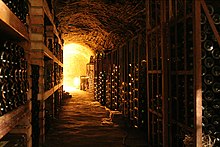
Wine is an alcoholic drink typically made from fermented grapes. Yeast consumes the sugar in the grapes and converts it to ethanol and carbon dioxide, releasing heat in the process. Different varieties of grapes and strains of yeasts are major factors in different styles of wine. These differences result from the complex interactions between the biochemical development of the grape, the reactions involved in fermentation, the grape's growing environment (terroir), and the wine production process. Many countries enact legal appellations intended to define styles and qualities of wine. These typically restrict the geographical origin and permitted varieties of grapes, as well as other aspects of wine production. Wines can be made by fermentation of other fruit crops such as plum, cherry, pomegranate, blueberry, currant and elderberry.

In passive solar building design, windows, walls, and floors are made to collect, store, reflect, and distribute solar energy, in the form of heat in the winter and reject solar heat in the summer. This is called passive solar design because, unlike active solar heating systems, it does not involve the use of mechanical and electrical devices.
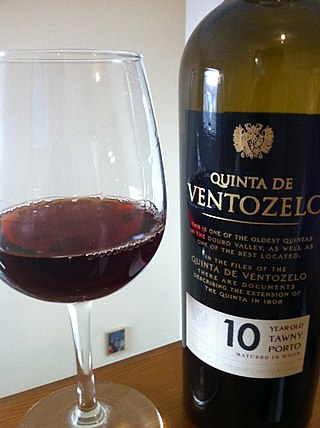
Port wine is a Portuguese fortified wine produced in the Douro Valley of northern Portugal. It is typically a sweet red wine, often served with dessert, although it also comes in dry, semi-dry, and white varieties.

Akvavit or aquavit is a distilled spirit that is principally produced in Scandinavia, where it has been produced since the 15th century. Akvavit is distilled from grain or potatoes, and is flavoured with a variety of herbs. It is also popular in Northern Germany.

A humidor is a humidity-controlled box or room used primarily for storing cigars, cigarettes, cannabis, or pipe tobacco. Either too much or too little humidity can be harmful to tobacco products; a humidor's primary function is to maintain a steady, desirable moisture level inside; secondarily it protects its contents from physical damage and deterioration from sunlight. For private use, small wooden boxes holding a few dozen or fewer cigars are common, while cigar shops may have walk-in humidors. Many humidors use hygrometers to monitor their humidity levels.
Wine accessories are things that may be used in the storage or serving of wine. Wine accessories include many items such as wine glasses, corkscrews, and wine racks.

A yakhchāl is an ancient type of ice house, which also made ice. They are primarily found in the Dasht-e Lut and Dasht-e-Kavir deserts, whose climates range from cold (BWk) to hot (BWh) desert regions.
A wine fault is a sensory-associated (organoleptic) characteristic of a wine that is unpleasant, and may include elements of taste, smell, or appearance, elements that may arise from a "chemical or a microbial origin", where particular sensory experiences might arise from more than one wine fault. Wine faults may result from poor winemaking practices or storage conditions that lead to wine spoilage.
Alexis Lichine was a Russian wine writer and entrepreneur. He played a key role in promoting varietal labelling of wine, was a masterful salesman of wine, and owned Château Prieuré-Lichine and a share of Château Lascombes in the Médoc. He was married to actress Arlene Dahl from 1964 to 1969.
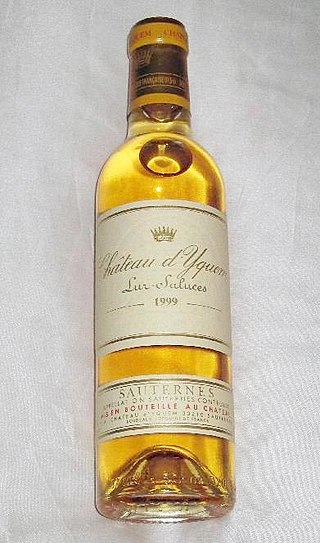
Sauternes is a French sweet wine from the region of the same name in the Graves section in Bordeaux. Sauternes wine is made from Sémillon, sauvignon blanc, and muscadelle grapes that have been affected by Botrytis cinerea, also known as noble rot. This causes the grapes to become partially raisined, resulting in concentrated and distinctively flavored wines. Due to its climate, Sauternes is one of the few wine regions where infection with noble rot is a frequent occurrence. Even so, production is a hit-or-miss proposition, with widely varying harvests from vintage to vintage. Wines from Sauternes, especially the Premier Cru Supérieur estate Château d'Yquem, can be very expensive, largely due to the very high cost of production. Barsac lies within Sauternes and is entitled to use either name. Somewhat similar but less expensive and typically less-distinguished wines are produced in the neighboring regions of Monbazillac, Cérons, Loupiac and Cadillac. In the United States, there is a semi-generic label for sweet white dessert wines known as sauterne without the "s" at the end and uncapitalized.
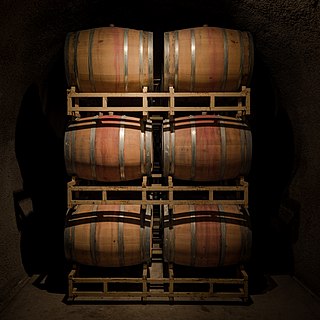
Wine caves are subterranean structures for the storage and the aging of wine. They are an integral component of the wine industry worldwide. The design and construction of wine caves represents a unique application of underground construction techniques.
The glossary of wine terms lists the definitions of many general terms used within the wine industry. For terms specific to viticulture, winemaking, grape varieties, and wine tasting, see the topic specific list in the "See also" section below.
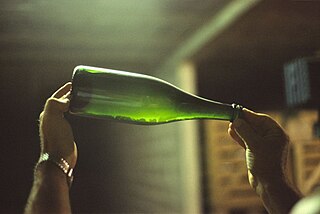
The traditional method is the process used in the Champagne region of France to produce Champagne. It is also the method used in various French regions to produce sparkling wines, in Spain to produce Cava, in Portugal to produce Espumante and in Italy to produce Franciacorta. The method is known as the méthode champenoise, but the Champagne producers have successfully lobbied the European Union to restrict the use of that term within the EU only to wines produced in Champagne. Thus, wines from elsewhere cannot use the term "méthode champenoise" on products sold in the EU, and instead the term "traditional method" or the local language equivalent. South African wines from the Western Cape are labelled with the term Methode Cap Classique. Some wine producers in countries outside the EU may disregard EU labeling laws and use méthode champenoise or even “Champagne” on labels for products not exported to the EU, but this usage is decreasing.

A root cellar, fruit cellar or earth cellar is a structure, usually underground or partially underground, used for storage of vegetables, fruits, nuts, or other foods. Its name reflects the traditional focus on root crops stored in an underground cellar, which is still often true; but the scope is wider, as a wide variety of foods can be stored for weeks to months, depending on the crop and conditions, and the structure may not always be underground.

A wine rack is a set of shelves for the organized storage of wine. Wine racks can be built out of a number of different materials. The size of the rack and the number of bottles it can hold can vary widely. Wine racks can be located in a winemaker’s professional wine cellar as well as private homes for personal collections.

Mileștii Mici is a Moldovan wine producer located in the commune of Mileștii Mici.

The aging of wine is potentially able to improve the quality of wine. This distinguishes wine from most other consumable goods. While wine is perishable and capable of deteriorating, complex chemical reactions involving a wine's sugars, acids and phenolic compounds can alter the aroma, color, mouthfeel and taste of the wine in a way that may be more pleasing to the taster. The ability of a wine to age is influenced by many factors including grape variety, vintage, viticultural practices, wine region and winemaking style. The condition that the wine is kept in after bottling can also influence how well a wine ages and may require significant time and financial investment. The quality of an aged wine varies significantly bottle-by-bottle, depending on the conditions under which it was stored, and the condition of the bottle and cork, and thus it is said that rather than good old vintages, there are good old bottles. There is a significant mystique around the aging of wine, as its chemistry was not understood for a long time, and old wines are often sold for extraordinary prices. However, the vast majority of wine is not aged, and even wine that is aged is rarely aged for long; it is estimated that 90% of wine is meant to be consumed within a year of production, and 99% of wine within 5 years.
This glossary of winemaking terms lists some of terms and definitions involved in making wine, fruit wine, and mead.
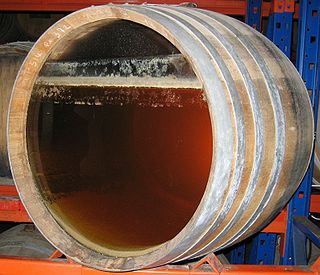
Ullage is a winemaking term that has several meanings but most commonly refers to the headspace of air between wine and the top of the container holding the wine. It can also refer to the process of evaporation that creates the headspace itself or it can be used as a past tense verb to describe a wine barrel or bottle that has gone through the evaporation process. The headspace of air is a mixture mostly of alcohol and water vapors with carbon dioxide that is a by-product of the fermentation process. In containers that are not completely air-tight, oxygen can also seep into this space. While some oxygen is beneficial to the aging process of wine, excessive amounts can lead to oxidation and other various wine faults. This is why wine in the barrels is regularly "topped up" and refilled to the top with wine in order to minimize the head space. In the bottle, the ullage or "fill level" of the wine can be an important indicator of the kind of care and storage conditions that the wine was kept in. After-market resellers and wine auction houses will often inspect the ullage levels of older vintages to determine the potential quality and value of wine.

Storage of wine is an important consideration for wine that is being kept for long-term aging. While most wine is consumed within 24 hours of purchase, fine wines are often set aside for long-term storage. Wine is one of the few commodities that can improve in flavour and value with age, but it can also rapidly deteriorate if kept in inadequate conditions.
